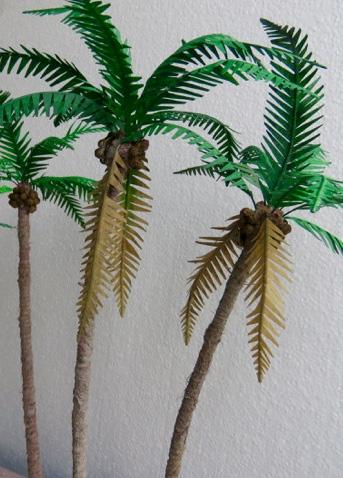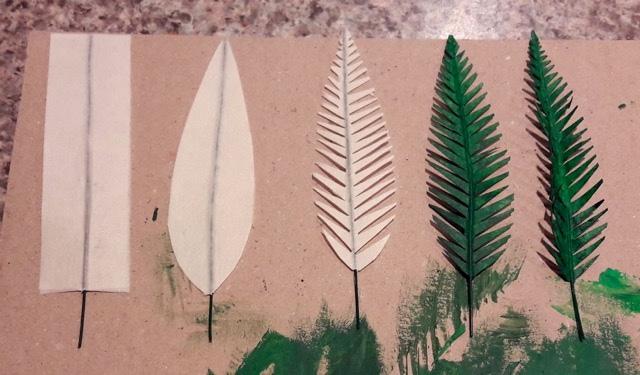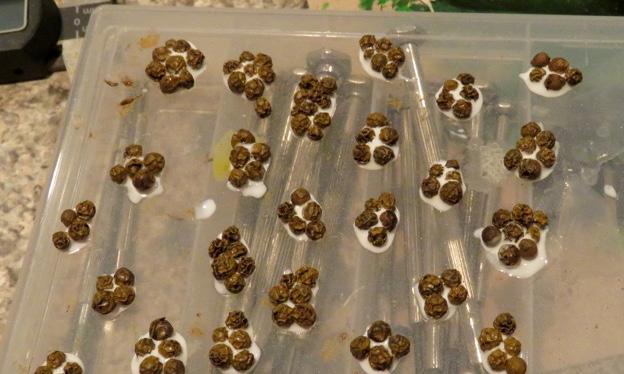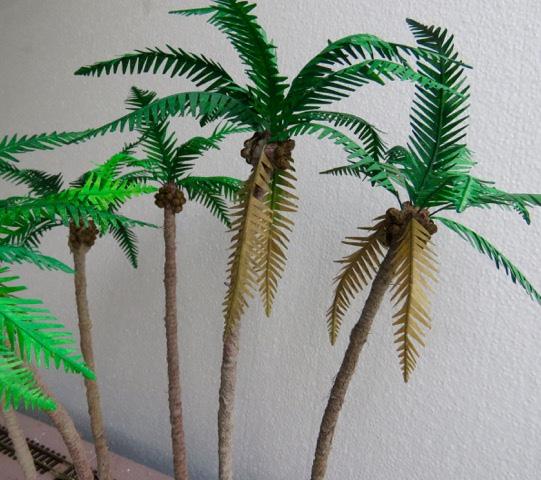
4 minute read
OH WHAT A LOVELY
Paul Napier
I am building an O scale (1/48th) diorama layout of a World War 2 Royal New Zealand Air Force airstrip somewhere in the South West Pacific. Our air force operated in this area from 1942 until wars end in 1945. The diorama also features a 2 foot (12 mm) gauge railway that would have been built by the Imperial Japanese Navy to assist with construction of the airstrip. One thing that is common in almost every picture of these Pacific airstrips is a stand of coconut trees in the background.
I figured I would need 60 to 70 coconut trees to run right along the back of the baseboards. I checked out what trees were available commercially, unfortunately I could find nothing even remotely close to the scale height of 30 m, the height to which coconut trees grow so scratch building was the only option.
Right. Part of the airfield scene Paul is trying to replicate.
Making Coconut Palms
1. This shows the stages of making a frond which grow 4 to 6 metres long. Cut thin wire to appropriate length allowing an additional one cm to imbed into top of the tree trunk. Place wire down the centre of the masking tape and fold the tape back on itself. Cut to shape with small sewing scissors and paint. Finally lightly bend leaves so they will hang down when placed on the tree.
1
2. The trunk is formed from three pieces of the thicker wire one being 1 to 2 cm longer to form the mounting pin. Wrap tape along the full length of the trunk then glue a small circle of cardboard at the bottom of the trunk with hot glue. Finally run hot glue along a few cm of

2
the trunk at a time and wrap cord around the trunk. These should be several layers of cord at both the base and top of the trunk. There is no need to be too tidy with the wrapping as this forms the rough rings of the trunk.
3


3. The cord is covered with the texture gel. I find this easiest to do with your fingers. When dry paint the trunk.

4. To form the coconuts, I use a box of Whole Black Peppercorns which can be painted green for immature coconuts or brown if representing ripe coconuts. Once the paint was dry I glue them into clumps by placing a bunch into PVA drops placed on a smooth plastic surface. Once dry the clumps are gently lifted off they are easy to glue onto the trunk with PVA.
5. To attach each frond to the trunk I drive a hole with a small screw driver or drill. Each frond is then secured in the hole with a small dab of super glue. Place and bend the fronds to give coverage both around the trunk and in the vertical. Brown dead fronds can also be replicated hanging down the trunk. Note the clumps of coconuts glued in place.
MATERIALS USED
• Florists stem wire 18 gauge • Florists stem wire 22 gauge • Florists stem wrap tape • A roll of coarse hemp cord • 50 mm wide masking tape • Reeves coarse texture gel • Peppercorns • Various colours of cheap acrylic paint 4



5
Paul’s airfield scene is quite prototypical and the information below backs this up.
In 1913, the Germans began construction of a light railway on Upolu, the main island of the then German Samoa, to transport building material from the waterfront at Apia to a wireless station. The railway was inaugurated on 1 August 1914, just as World War I began. The railway to the wireless station was approximately 4 miles (6.4 km) long, and a total of 8 miles (12.9 km) including the various branches to the coconut plantations. German Samoa was occupied on 30 August 1914 by an expeditionary force sent from New Zealand. When the New Zealand Railway Engineers unit of the 3rd Auckland Regiment arrived in Samoa, the line was in disrepair, however it was soon repaired and the petrol engine locomotive seized was quickly rebranded N.Z.R. and christened A1. The men apparently missed the omission of the customary whistle of an ‘A’ class engine and requested to arrange to have a whistle affixed to the engine, Whether this happened is unknown.
In 1939 the New Zealand Public Works Department built an air base for the Royal New Zealand Air Force at Nadi in Fiji. With the arrival of WWII and the American Forces in the Pacific there was a request in 1941 from the US Forces for the air base runway to be lengthened to provide a stopping off point and accommodate transport aircraft flying in the Pacific. The PWD ‘borrowed’ locomotives and rolling stock for the work required from the Colonial Sugar Company and imported others from New Zealand. The Lautoka to Kavanagasau sugar cane railway ran past the Nadi airfield and had to be rerouted around the airfield, forming a U shaped loop, adding a couple of kilometres to the route.
Information from the book: Cane Train by Peter Dyer and Peter Hodge. Available from the New Zealand Railway & Locomotive Society Inc www.railsoc.org.nz








